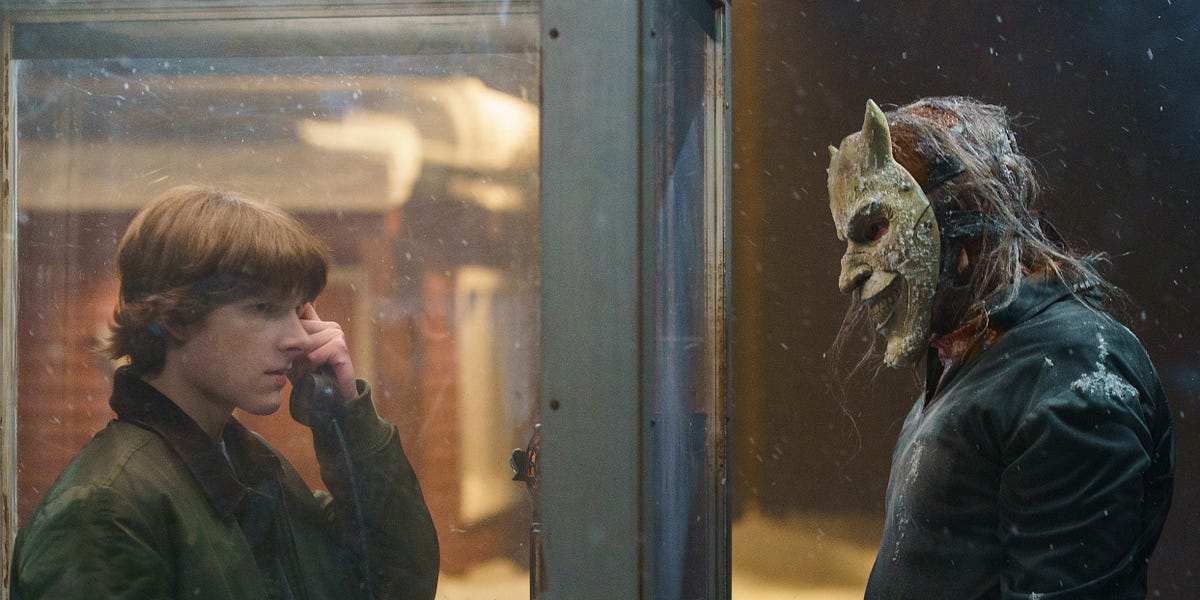The chilling sequel, ‘Black Phone 2,’ has arrived, bringing back the terror of The Grabber and the psychic abilities of Gwen. In his review for The Bulwark, Sonny Bunch delves into whether the movie captures the suspense of the original or falls flat due to its deviations from established logic. With Ethan Hawke reprising his role as the menacing villain, the film explores deeper, darker themes of faith, family, and the haunting nature of evil. But does it deliver?
Bunch examines the film’s strengths and weaknesses, focusing on the jump scares, musical score spikes, and the idiotic simplicity of the name ‘The Grabber.’ He questions whether the film’s exploration of Grabber lore enhances the narrative or complicates the unfussiness of the original. For fans of horror and suspense, this review offers critical insights into ‘Black Phone 2.’
The Questionable Logic of ‘Black Phone 2’
Sonny Bunch grapples with the internal logic of ‘Black Phone 2,’ questioning whether the writers’ disregard for rules enhances the ghostly premise or detracts from it. He writes:
I honestly can’t tell if I admire cowriters C. Robert Cargill and Scott Derrickson for simply saying that there didn’t need to be any internal logic to Black Phone 2 or if I was annoyed by the wanton lack of rules and rigor.
Bunch typically insists on internal consistency, allowing for any ridiculous element as long as it aligns with the established universe. He finds it plausible that The Grabber (Ethan Hawke) transcends death and escapes Hell by feeding off his victims’ terror and can invade Gwen’s (Madeleine McGraw) dreams to torment her. However, he struggles with The Grabber’s ability to communicate with Armando and manifest a blood-eyed snowman, citing inconsistencies in how The Grabber interacts with the real world.
Jump Scares and Musical Score Spikes
Despite his reservations about the plot, Bunch acknowledges the effectiveness of the film’s jump scares and musical score. Director Derrickson skillfully creates moments that startle and thrill. Bunch notes:
Derrickson does a great job of making you spring out of your seat with the quick-cut jump scares and musical score spikes.
These techniques serve to create a suspenseful viewing experience, enhancing the film’s overall impact. However, the reliance on these elements raises the question of whether they compensate for the film’s narrative inconsistencies or simply distract from them.
The Intriguing Simplicity of ‘The Grabber’
Bunch appreciates the ‘idiotic simplicity’ of the name ‘The Grabber,’ finding it refreshingly straightforward. He explains that the name effectively encapsulates the character’s purpose:
All of the spooky elements from the original film were in service of stopping The Grabber from grabbing kids, and I thought that was great. The unfussiness of the original, though, is complicated by the sequel’s addiction to Grabber lore.
The sequel delves into the backstory of The Grabber, detailing his previous victims and how he has secretly affected Finney and Gwen’s lives. While this exploration adds depth, it also complicates the simplicity that made the original film so effective.
Ethan Hawke’s Theatrical Menace
Ethan Hawke’s performance as The Grabber remains a highlight of the film. Although Bunch feels Hawke’s presence could have been more prominent, he acknowledges the actor’s raw theatrical menace. In quieter scenes, Hawke portrays the villain as exhausted and reluctant, driven by a compulsion instilled by hell. As Bunch describes:
Hawke plays the villain as exhausted and almost reluctant; he’s driven to his villainy here by a compulsion instilled by the depredations of hell.
Hawke’s portrayal adds complexity to the character, illustrating the torment of being consumed by wickedness.
Themes of Faith and Family
The movie touches on themes of faith and family, highlighting how those who preach against bad words and thoughts may not always be virtuous. However, Bunch suggests that these themes are not where the series truly shines:
These are simple movies about a child killer and his victims’ ghosts. In particular, I’ve always appreciated the idiotic simplicity of the name “The Grabber.”
The strength of the series lies in its core elements: a child killer and the vengeful spirits of his victims. The simplicity and directness of this premise are what make the narrative so compelling.
More of The Grabber, Please
The Grabber’s iconic design—particularly the horned mask that detaches at the jawline—is a major draw, creating a villain that has the potential to spawn a whole franchise. Bunch argues that the film could have benefited from more of The Grabber, noting that Hawke’s scenes, though impactful, feel limited. Bunch elucidates:
Black Phone 2 honestly could have used a little bit more of The Grabber: Ethan Hawke isn’t wasted, precisely, but you do get the sense that Derrickson had him on set for about four days and made the most of it.
Additional scenes featuring Hawke could have deepened the character and enhanced the film’s overall impact, providing a more substantial exploration of his motivations and torment.
Final Thoughts on ‘Black Phone 2’
In conclusion, ‘Black Phone 2’ presents a mixed bag of thrills and narrative inconsistencies. While the jump scares and Ethan Hawke’s performance as The Grabber offer moments of genuine suspense, the film’s questionable logic and complex lore may detract from the simplicity that made the original so effective. As Sonny Bunch suggests, the film’s value lies in its ability to startle and entertain, even if it falls short on internal consistency.
Ultimately, ‘Black Phone 2’ is a worthy watch for fans of the horror genre. It balances chilling moments with deeper explorations of its villain, even if the narrative strays into less coherent territory. The series could greatly benefit from focusing on more of ‘The Grabber,’ as well.

Leave a Reply